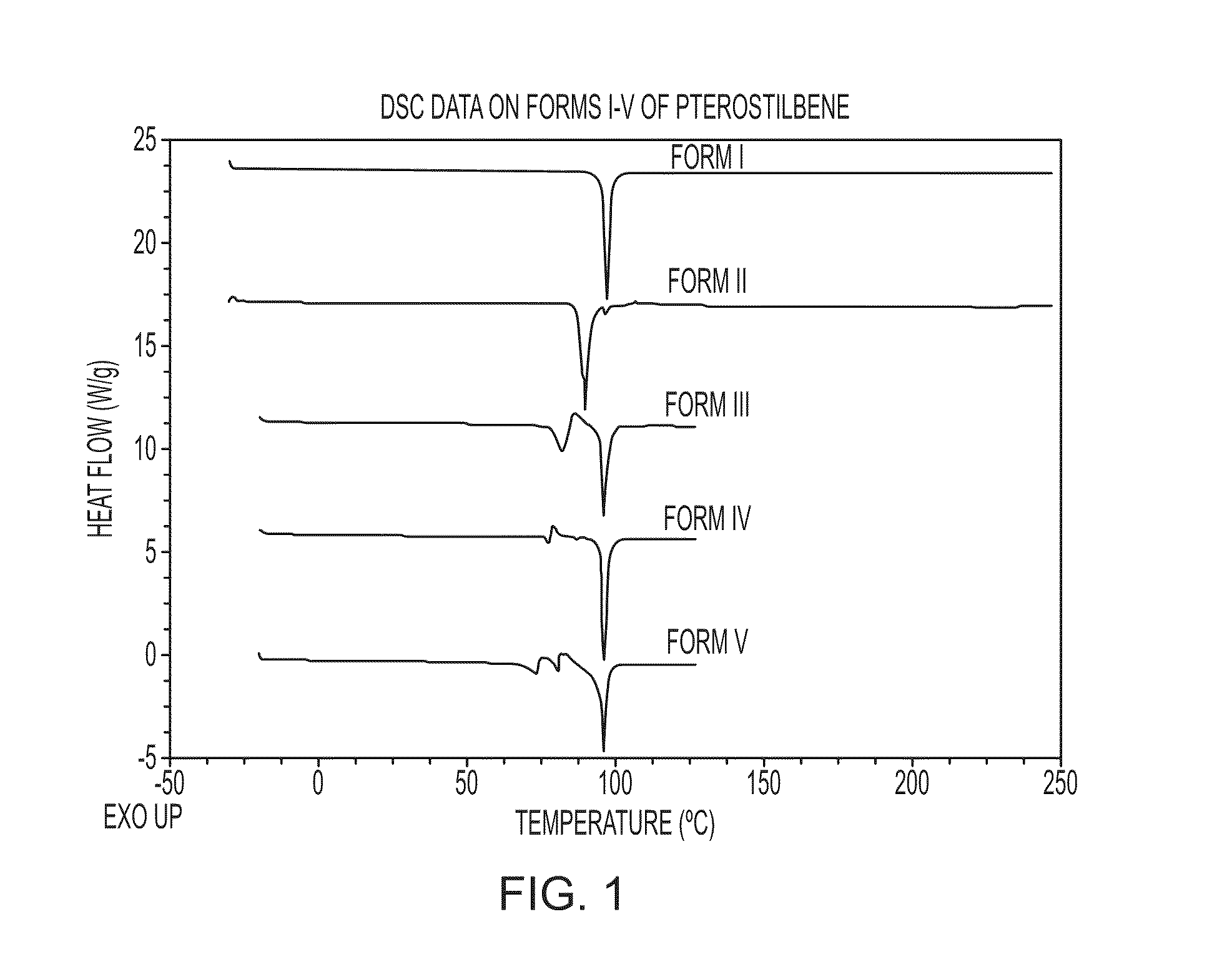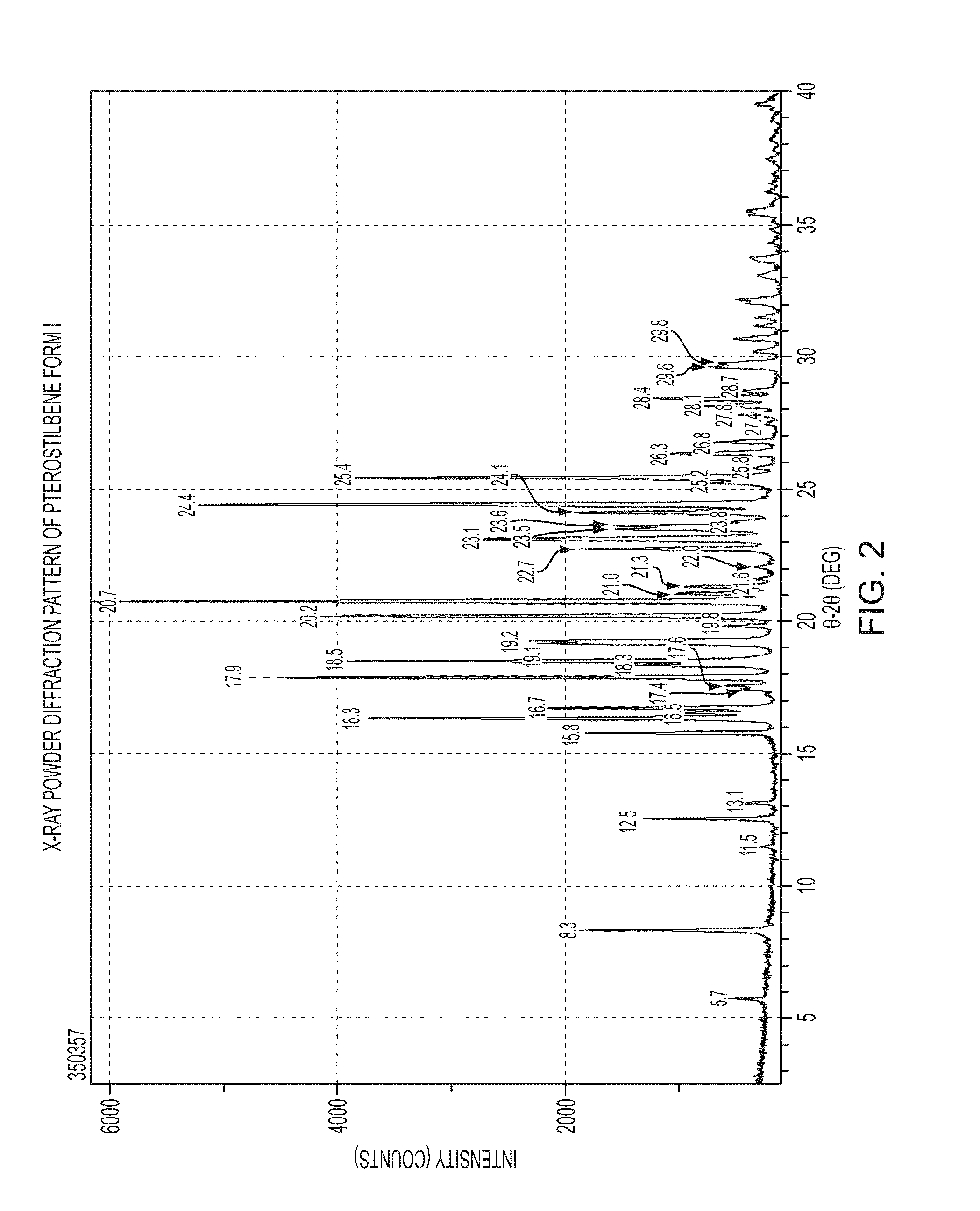Key intermediate for the preparation of stilbenes, solid forms of pterostilbene, and methods for making the same
a technology of pterostilbene and key intermediate, which is applied in the field of key intermediate for the preparation of pterostilbene, solid forms of pterostilbene, and methods for making the same, can solve the problems of poor solubility in water, difficulty in selective deprotection preparation of pterostilbene, and use of expensive reagents for protection and/or low yield in the process
- Summary
- Abstract
- Description
- Claims
- Application Information
AI Technical Summary
Benefits of technology
Problems solved by technology
Method used
Image
Examples
example 1
Synthesis of Pterostilbene
[0119]Step-1.1: To the sodium hydride (1.66 g, 0.0694 mol) suspension in tetrahydrofuran (40 ml) at 0° C. was added diethyl-3,5-dimethoxy benzyl phosphonate (10 g, 0.0347 mol) and resulting dark solution was stirred under nitrogen at room temperature for 30 min. A solution of 4′-O-tetrahydropyranyl benzaldehyde (7.84 g, 0.0381 mol), in tetrahydrofuran (20 ml) was added at 18-20° C. and the mixture stirred at room temperature for about 2-3 hours. After completing the reaction added methanol (10 ml) drop wise at 0-5° C., resulting solution was poured into ice-water and extracted with ethyl acetate (50 ml). Organic layer washed with water (10 ml) and dried over sodium sulfate and removed ethyl acetate under reduced pressure at 40° C. to obtain semi solid and which on treating with methanol given pure solid compound (8.2 g, purity by HPLC 98.4%).
[0120]Step-1.2: To a solution of 3,5-Dimethoxy-4′-O-tetrahydropyranyl stilbene (10 g, 0.0294 mol) in methanol (50 ml)...
example 2
Synthesis of Resveratrol
[0121]Step-2.1: To the sodium hydride (1.66 g, 0.0694 mol) suspension in tetrahydrofuran (40 ml) at 0° C. was added diethyl-3,5-dimethoxy benzyl phosphonate (10 g, 0.0347 mol) and resulting dark solution was stirred under nitrogen at room temperature for 30 min. A solution of 4′-O-tetrahydropyranyl benzaldehyde (7.84 g, 0.0381 mol) in tetrahydrofuran (20 ml) was added at 18-20° C. and the mixture stirred at room temperature for about 2-3 hours. After completing the reaction added methanol (10 ml) drop wise at 0-5° C., resulting solution was poured into ice-water and extracted with ethyl acetate (50 ml). Organic layer washed with water (10 ml) and dried over sodium sulfate and removed ethyl acetate under reduced pressure at 40° C. to obtain semi solid and which on treating with methanol given pure solid compound (8.2 g, purity by HPLC 98.4%).
[0122]Step-2.2: To a solution of N,N-Dimethylaniline (32 g, 0.264 mol) in 500 ml RB flask at RT, was added slowly Alumin...
example 3
Screens for Pterostilbene Solid Forms
[0136]Several types of high-throughput and manual crystallization experiments were conducted on Forms I and II of Pterostilbene using many different types of solvents. The solvents were chosen to span a wide range of polarities, functional groups, hydrogen bonding potentials, and the like. In addition, various solvent mixtures were utilized. Crystallization techniques included slow evaporation, fast evaporation, slow cool, crash cool, crash precipitation, ambient and elevated temperature slurrying, and sonication. Five crystalline polymorphs, x-ray amorphous material and a t-butanol solvate of Pterostilbene were identified during the screen. The crystallization and synthetic methods listed for the various forms below were also used to prepare the forms.
PUM
| Property | Measurement | Unit |
|---|---|---|
| Melting point | aaaaa | aaaaa |
| Melting point | aaaaa | aaaaa |
| Temperature | aaaaa | aaaaa |
Abstract
Description
Claims
Application Information
 Login to View More
Login to View More - R&D
- Intellectual Property
- Life Sciences
- Materials
- Tech Scout
- Unparalleled Data Quality
- Higher Quality Content
- 60% Fewer Hallucinations
Browse by: Latest US Patents, China's latest patents, Technical Efficacy Thesaurus, Application Domain, Technology Topic, Popular Technical Reports.
© 2025 PatSnap. All rights reserved.Legal|Privacy policy|Modern Slavery Act Transparency Statement|Sitemap|About US| Contact US: help@patsnap.com



